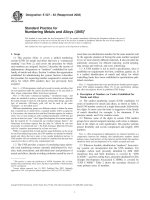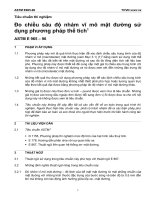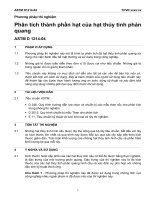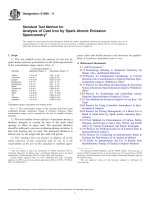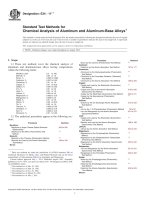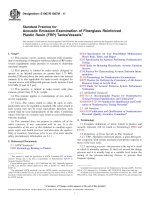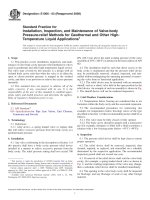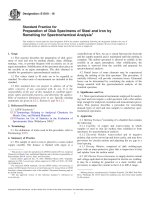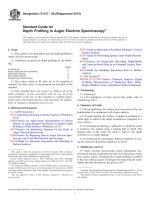Astm e 1214 11e1
Bạn đang xem bản rút gọn của tài liệu. Xem và tải ngay bản đầy đủ của tài liệu tại đây (84.36 KB, 3 trang )
This international standard was developed in accordance with internationally recognized principles on standardization established in the Decision on Principles for the
Development of International Standards, Guides and Recommendations issued by the World Trade Organization Technical Barriers to Trade (TBT) Committee.
Designation: E1214 − 11´1
Standard Guide for
Use of Melt Wire Temperature Monitors for Reactor Vessel
Surveillance1
This standard is issued under the fixed designation E1214; the number immediately following the designation indicates the year of
original adoption or, in the case of revision, the year of last revision. A number in parentheses indicates the year of last reapproval. A
superscript epsilon (´) indicates an editorial change since the last revision or reapproval.
ε1 NOTE—The title of this guide and the Referenced Documents were updated editorially in May 2017.
2. Referenced Documents
1. Scope
2.1 ASTM Standards:2
E185 Practice for Design of Surveillance Programs for
Light-Water Moderated Nuclear Power Reactor Vessels
E706 Master Matrix for Light-Water Reactor Pressure Vessel
Surveillance Standards
E794 Test Method for Melting And Crystallization Temperatures By Thermal Analysis
E900 Guide for Predicting Radiation-Induced Transition
Temperature Shift in Reactor Vessel Materials
E2215 Practice for Evaluation of Surveillance Capsules
from Light-Water Moderated Nuclear Power Reactor Vessels
1.1 This guide describes the application of melt wire temperature monitors and their use for reactor vessel surveillance
of light-water power reactors as called for in Practices E185
and E2215.
1.2 The purpose of this guide is to recommend the selection
and use of the common melt wire technique where the
correspondence between melting temperature and composition
of different alloys is used as a passive temperature monitor.
Guidelines are provided for the selection and calibration of
monitor materials; design, fabrication, and assembly of monitor and container; post-irradiation examinations; interpretation
of the results; and estimation of uncertainties.
1.3 The values stated in SI units are to be regarded as
standard. The values given in parentheses are mathematical
conversions to inch-pound units that are provided for information only and are not considered standard.
1.4 This standard does not purport to address all of the
safety concerns, if any, associated with its use. It is the
responsibility of the user of this standard to establish appropriate safety and health practices and determine the applicability of regulatory limitations prior to use. (See Note 1.)
1.5 This international standard was developed in accordance with internationally recognized principles on standardization established in the Decision on Principles for the
Development of International Standards, Guides and Recommendations issued by the World Trade Organization Technical
Barriers to Trade (TBT) Committee.
3. Significance and Use
3.1 Temperature monitors are used in surveillance capsules
in accordance with Practice E2215 to estimate the maximum
value of the surveillance specimen irradiation temperature.
Temperature monitors are needed to give evidence of overheating of surveillance specimens beyond the expected temperature. Because overheating causes a reduction in the amount of
neutron radiation damage to the surveillance specimens, this
overheating could result in a change in the measured properties
of the surveillance specimens that would lead to an unconservative prediction of damage to the reactor vessel material.
3.2 The magnitude of the reduction of radiation damage
with overheating depends on the composition of the material
and time at temperature. Guide E900 provides an accepted
method for quantifying the temperature effect. Because the
evidence from melt wire monitors gives no indication of the
duration of overheating above the expected temperature as
1
This guide is under the jurisdiction of ASTM Committee E10 on Nuclear
Technology and Applicationsand is the direct responsibility of Subcommittee
E10.02 on Behavior and Use of Nuclear Structural Materials.
Current edition approved July 1, 2011. Published September 2011. Originally
approved in 1987. Last previous edition approved in 2006 as E1214–06. DOI:
10.1520/E1214-11E01.
2
For referenced ASTM standards, visit the ASTM website, www.astm.org, or
contact ASTM Customer Service at For Annual Book of ASTM
Standards volume information, refer to the standard’s Document Summary page on
the ASTM website.
Copyright © ASTM International, 100 Barr Harbor Drive, PO Box C700, West Conshohocken, PA 19428-2959. United States
1
E1214 − 11´1
5. Design, Fabrication, and Assembly of Monitor and
Container
indicated by melting of the monitor, the significance of
overheating events cannot be quantified on the basis of
temperature monitors alone. Indication of overheating does
serve to alert the user of the data to further evaluate the
irradiation temperature exposure history of the surveillance
capsule.
5.1 The design of the monitor and its container shall ensure
that the maximum temperature of the surveillance specimens is
determined within 610°C (618°F).
5.2 The design shall provide for a minimum of one set of
monitors for each surveillance capsule. Additional sets of
monitors are recommended to characterize the in-service axial
temperature profiles necessary to determine the maximum
temperature of each surveillance specimen.
3.3 This guide is included in Master Matrix E706 that
relates several standards used for irradiation surveillance of
light water reactor vessel materials. It is intended primarily to
amplify the requirements of Practice E185 in the design of
temperature monitors for the surveillance program. It may also
be used in conjunction with Practice E2215 to evaluate the
post-irradiation test measurements..
5.3 The design of the monitor and its container shall ensure
that the monitor will readily sense the environmental temperature of the surveillance specimens and yet not be subject to any
influences from fabrication or assembly or even post-service
examination. The monitors typically consist of melt wires
positioned adjacent to or among the surveillance specimens.
4. Selection and Calibration of Monitor Materials
4.1 Selection of Monitor Materials:
4.1.1 Materials selected for temperature monitors shall possess unique melting temperatures. Since composition, and
particularly the presence of impurities, strongly influence
melting temperature, the fabricated monitor materials shall
consist of either metals of purity 99.9 % or greater or eutectic
alloys such that the measured melting temperature is within
63°C (65°F) of the recognized melting temperature.
Transmutation-induced changes of the monitor materials suggested in 4.1.2 are not considered significant for fluence
exposures up to 1 × 1020 n/cm2 (E > 1 MeV) relative to the
goal of these temperature monitors in flagging deviations from
expected temperatures.
4.1.2 The monitor materials in Table 1 provide temperature
indications in the range of 266 to 327°C (511 to 621°F). Other
metals or alloys may be selected for the temperatures of
interest provided the monitor materials meet the technical
requirements of this guide.
4.1.3 The chosen monitor materials shall be carefully evaluated for radiological health hazards.
5.4 The quantity of monitors within each set shall be
adequate to identify any temperature excursion of 10°C (18°F)
up to the highest potential temperature, such as 330°C (626°F).
It is recommended that monitors be selected to measure
temperature at intervals of 5 to 12°C (9 to 22°F). At least one
monitor shall remain intact throughout the service life; therefore the highest temperature monitor shall possess a melting
temperature greater than the highest anticipated temperature.
5.5 Fabrication and assembly of the monitors and containers
shall protect and maintain the integrity of each temperature
monitor and its ability to respond by melting at the environmental temperature of the surveillance specimens corresponding to the monitors’ melting temperature. The monitors and
containers shall be designed, fabricated and assembled to
ensure that the monitors melt at a temperature within 63°C
(5°F) of the environmental temperature of the specimens.
5.6 Identification of each monitor, its material and melting
temperature, and its orientation and location in the surveillance
capsule shall be maintained. Provision for means of verification shall be done by design.
NOTE 1—It is beyond the scope of this guide to provide safety and
health criteria, and the user is cautioned to seek further guidance.
4.2 Calibration of Monitor Materials— Each lot of monitor
materials shall be calibrated by melting tests to establish the
actual melting temperatures. The melting temperature tests
shall be conducted in accordance with Test Method E794. If an
alternate method of calibration is used, the procedure and
equipment must be described, the resultant mean values and
uncertainties must be reported, and traceability to standards
must be declared.
6. Post-Irradiation Examination
6.1 Following irradiation, the temperature monitors shall be
examined for evidence of melting to establish the maximum
exposure temperature of the encapsulated surveillance specimens. Precautions should be taken while recovering the monitors from the surveillance capsule and during subsequent
examination.
6.1.1 The monitor design and method of encapsulation shall
be considered in the recovery procedure to ensure that the
monitors are not damaged and that the original identity of
individual monitors and their location is maintained.
6.1.2 Recovery and examination of the monitors should be
performed remotely or with sufficient shielding to protect the
operator from unnecessary radiation exposure.
TABLE 1 Monitor Material Melting Temperatures
Monitor Material,
Weight %
Cd–17.4 Zn
Au–20.0 Sn
Pb–5.0 Ag–5.0 Sn
Pb–2.5 Ag
Pb–1.5 Ag–1.0 Sn
Pb–1.75 Ag–0.75 Sn
Cd–1.2 Cu
Cd
Pb
Melting Temperature,
°C
Melting Temperature,
°F
266
280
292
304
309
310
314
321
327
511
536
558
579
588
590
597
610
621
6.2 Evaluation of the temperature monitors after service for
evidence of melting should be performed using suitable equipment that is dependent on the design of the monitor container
and the examination facility. When visual inspection of the
monitors is possible, such as with periscopes, each monitor
2
E1214 − 11´1
the ability of the monitor to accurately indicate the environmental temperature, the relationship in temperature between
the monitors and the specimens, and the bias in discriminating
melting.
shall be examined and the results recorded. When possible,
photographic records should be made of each monitor or set of
monitors. When visual inspection is not practical or conclusive,
radiography or metallographic examination may be necessary.
Destructive examination should be performed only if further
confirmation of the melting temperature is necessary.
8.2 All known and estimated uncertainties, including a
description of their determination, shall be reported with the
estimated maximum exposure temperatures.
6.3 The monitors shall be evaluated on the following basis:
6.3.1 Unmelted—No evidence of melting of any portion of
the monitor.
6.3.2 Partially Melted—Any evidence of any melting of any
portion of the monitor.
6.3.3 Fully Melted—Evidence that the entire monitor was
subject to melting.
6.4 If there is reason to question the results, monitors should
be reevaluated after completion of the post-irradiation examination to ensure that there was no change in the melting
temperature. This verification of melting temperature may be
performed as described in 4.2.
8.3 Uncertainties resulting from unresolved ambiguities
shall be described. Probable causes and subsequent implications should be stated.
9. Report
9.1 In addition to the reporting requirements of Practices
E185 and E2215, the following information shall be reported:
9.1.1 Description of the temperature monitors including
chemical composition of the monitor melt wires and their
respective melting temperatures with uncertainties, container
design, identification, and location in the irradiation capsule.
9.1.2 Results of the post-service evaluation in which each
monitor condition is characterized as unmelted, partially
melted, or fully melted.
9.1.3 The estimated maximum exposure temperature range
of the surveillance specimens and the associated uncertainties.
9.1.4 The agreement between the temperature monitor results and the historical service conditions and description of
any anomalies found while recovering, examining, or evaluating the monitors.
9.1.5 Results of any additional examinations, if performed,
to resolve inconsistent monitor results.
7. Interpretation
7.1 The design of the melt wire configuration should prevent ambiguities as to incipient melting. However, there may
be circumstances where melting is questionable. Change in
shape, slumping, and segmenting are indications of melting.
When initial examination results are uncertain, this shall be
documented. Further nondestructive and destructive examinations may be performed if warranted to verify the condition of
the monitor.
7.2 The condition of the monitors should be consistent
according to axial position and expected relative temperatures.
7.3 The range of possible maximum service temperatures of
the surveillance specimen shall be estimated and documented,
based upon the indications provided by the temperature monitors. The temperature estimate should consider the design of
the monitor and container, the location of specimens relative to
the monitors, and potential temperature gradients.
7.4 Discrepancies between the temperature monitor results
and historical service conditions shall be assessed and described.
9.2 The following additional documentation should be reported if available:
9.2.1 Photographs of each irradiated temperature monitor
that document the visual observations.
9.2.2 Preirradiation test results used to certify the melting
temperatures of each monitor type.
9.2.3 Test results, if performed, verifying post-irradiation
melting temperature for each monitor.
10. Keywords
8. Estimation of Uncertainties
8.1 Uncertainties arise from limitations in precision and bias
in determining the initial melting temperatures of each monitor,
10.1 nuclear reactor vessels; neutron irradiation; surveillance (of nuclear reactor vessels)
ASTM International takes no position respecting the validity of any patent rights asserted in connection with any item mentioned
in this standard. Users of this standard are expressly advised that determination of the validity of any such patent rights, and the risk
of infringement of such rights, are entirely their own responsibility.
This standard is subject to revision at any time by the responsible technical committee and must be reviewed every five years and
if not revised, either reapproved or withdrawn. Your comments are invited either for revision of this standard or for additional standards
and should be addressed to ASTM International Headquarters. Your comments will receive careful consideration at a meeting of the
responsible technical committee, which you may attend. If you feel that your comments have not received a fair hearing you should
make your views known to the ASTM Committee on Standards, at the address shown below.
This standard is copyrighted by ASTM International, 100 Barr Harbor Drive, PO Box C700, West Conshohocken, PA 19428-2959,
United States. Individual reprints (single or multiple copies) of this standard may be obtained by contacting ASTM at the above
address or at 610-832-9585 (phone), 610-832-9555 (fax), or (e-mail); or through the ASTM website
(www.astm.org). Permission rights to photocopy the standard may also be secured from the Copyright Clearance Center, 222
Rosewood Drive, Danvers, MA 01923, Tel: (978) 646-2600; />
3
